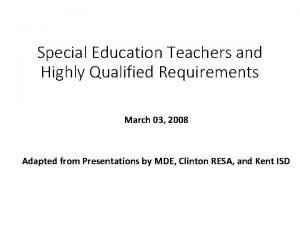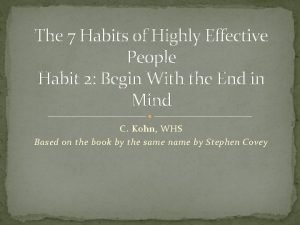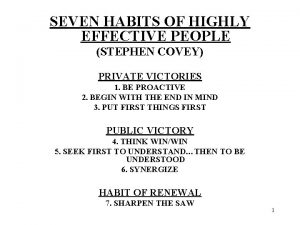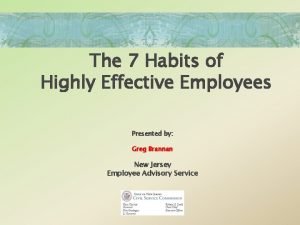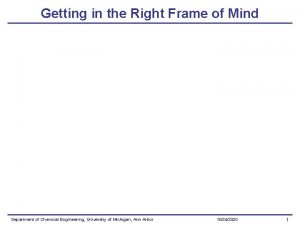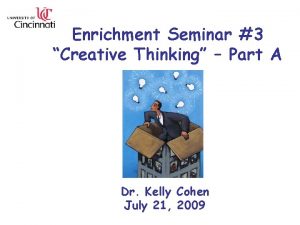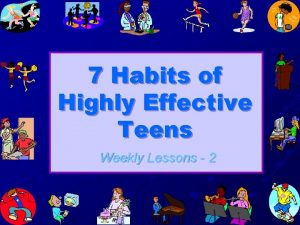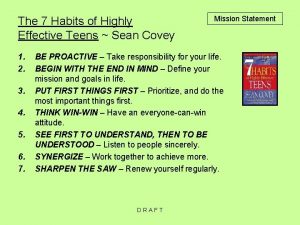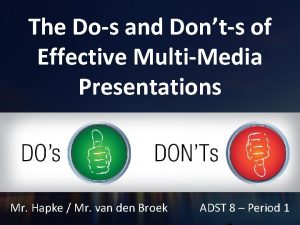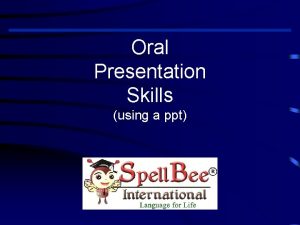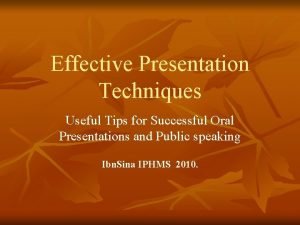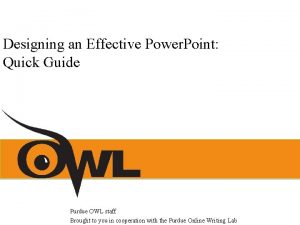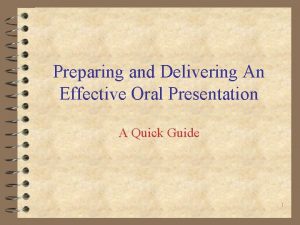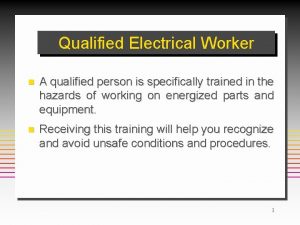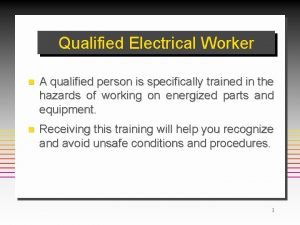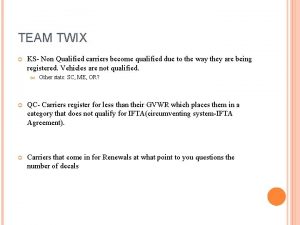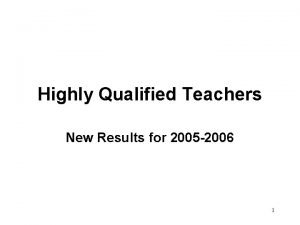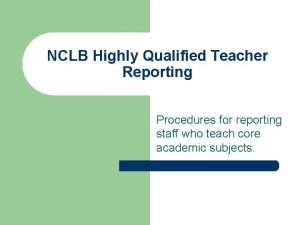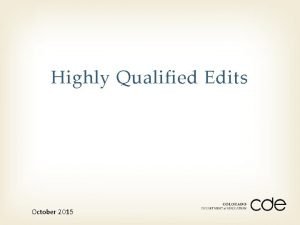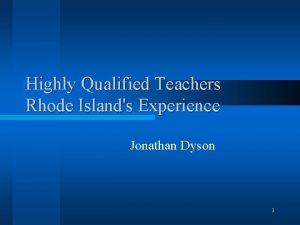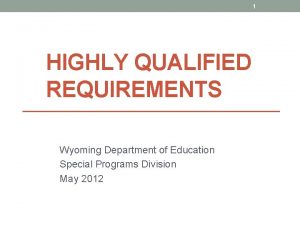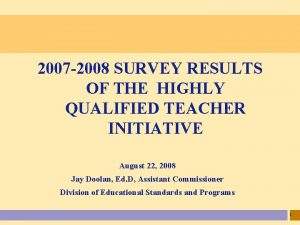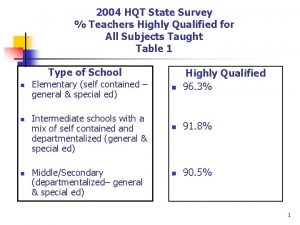Presentation Intro From Highly Qualified to Highly Effective





















- Slides: 21

Presentation Intro

From Highly Qualified to Highly Effective: Research on the Impact of Educators on Student Learning Sabrina W. M. Laine, Ph. D. Learning Point Associates Measuring What Matters- Paying for Teacher Quality Forum September 14, 2009

The Impact of Teachers • Teachers drive student performance ▪ Teachers are the greatest school-based influence on student achievement (Nye, Konstantopolous, & Hedges, 2004). • “Americans identified two issues as most important in moving schools in the right direction: better teachers and more parental support. ” (Bushaw & Mc. Nee, 2009)

Current Policy • Federal policy on teacher quality currently focuses on teacher “inputs” • As established by the 2001 reauthorization of the Elementary and Secondary Education Act (ESEA), a “highly qualified teacher” has the following: ▪ A college degree ▪ Content-area undergraduate major ▪ State teaching certification

Measuring Input is not Enough • Inputs (certification status, degree, subject area major) do not greatly impact student achievement (Rice, 2003; Roza & Miller, 2009) • Recent research is shifting from teacher quality to teaching quality ▪ As a concept, teacher effectiveness measures teaching quality through contributions to student growth and learning

Framework for Thinking Beyond Teacher Quality Teacher Qualifications - HQT Status - Degrees - State Certification - Experience Teacher Performance Expertise - Pedagogical knowledge - Content knowledge for teaching Capacity - Verbal intelligence - Willingness to learn - Preparedness Character/Dispositions - Sensitivity - Warmth - Commitment - Passion Are enacted in and shaped by Teachers Students Content Which influences Student Outcomes / Teacher Effectiveness

Quality versus Effectiveness • Indicators of Quality ▪ HQT Status ▪ Teacher Expertise • Indicators of Effectiveness ▪ Demonstrated contributions to student learning outcomes (value -added scores, student work ▪ Teacher Capacity ▪ Teacher Character ▪ Teacher Performance samples) ▪ Demonstrated contributions to other desired student outcomes (social-emotional outcomes, student engagement, attendance/graduation rates, student/parent/alumni surveys)

Five Point Definition National Comprehensive Center for Teacher Quality: http: //www. tqsource. org/publications/practical. Guide. pdf 1. Have high expectations for all students and help students learn, as measured by value-added or other test-based growth measures, or by alternative measures 2. Contribute to positive academic, attitudinal, and social outcomes for students such as regular attendance, on-time promotion to the next grade, on-time graduation, self-efficacy, and cooperative behavior

Five Point Definition, cont. 3. Use diverse resources to plan and structure engaging learning opportunities; monitor student progress formatively, adapting instruction as needed; and evaluate learning using multiple sources of evidence 4. Contribute to the development of classrooms and schools that value diversity and civic mindedness 5. Collaborate with other teachers, administrators, parents, and education professional to ensure student success, particularly the success of students with special needs and those at high risk for failure

How to Measure Effectiveness • What are the instruments? What are the variables? What are the outcome measures? • Examples of Current Practice ▪ ▪ ▪ Review of Teacher Lesson plans Classroom observations Self-assessments Portfolio assessments Student achievement data Student work sample reviews

What the Research Says about Value-Added • Advantages (Goe & Croft, 2009) ▪ Relatively inexpensive, after initial infrastructure costs ▪ Focuses solely and directly on student learning ▪ Relatively objective ▪ Comparable across schools, districts, and states (provided they use the same statistical methods and achievement tests) • Disadvantages (Goe & Croft, 2009) ▪ Can be costly to build data system from scratch ▪ No information about what effective teachers do in the classroom ▪ No information to help teachers improve ▪ No information for some teachers (e. g. special education, art, music, early elementary)

How to Measure Effectiveness Teacher Qualifications Education, certification, credentials, teacher test scores, and experience Processes Teacher Practices (Teaching Quality) Practices both in and out of the classroom (impacted by school and classroom context): planning, instructional delivery, classroom management, interactions with students Inputs Teacher Characteristics Attitudes, attributes, beliefs, self-efficacy, race, gender Teacher Quality Student Achievement Test Scores (treated as indicator of teacher quality) Outcomes Teacher Effectiveness Student Achievement (predicted) – Student Achievement (actual) = Student Gain Score Empirically defined using value-added measures; teachers are ranked by how much students gained compared to how much they were predicted to gain in achievement. 12 Source: Goe, Bell, & Little; 2008

Where is the Field on this Issue? • Administrators are the most common evaluators according to study of 140 districts • On average, non-tenured teachers evaluated twice a year and tenured teachers once every three to five years (Brandt, et al. , 2007) • More than 6 in 10 teachers prefer a principal who visits frequently and provides detailed feedback as opposed to yearly formal observations (Public Agenda/LPA 2009)

Where is the Field, cont. • 66% of teachers who give their principals fair/poor ratings consider lack of administrative support a major drawback of teaching • 87% of the same group believe principals would use performance pay to play favorites and reward teachers who are loyal • More than 7 in 10 teachers would choose a school with better administrative support over a school with a higher salary (Public Agenda/LPA 2009)

A Systemic Approach that Includes Compensation Reform

Example of a Systemic Approach Recruitment Hiring Induction Professional Working Compensation and Performance and Development Conditions Incentives Management Mentoring • Implement early hiring timelines. • Provide differentiated, ongoing, job-embedded professional development. • Ensure that workloads are reasonable. • Offer long-term salary policies that are market-sensitive, competitive, and performance-based. 16

Focus on What Matters • America’s central educational challenge is to dramatically improve student performance. ▪ Teachers drive student performance • We need a systemic approach to ensure the most effective teacher in every classroom and most effective leader in every school.

References • Brandt, C. , Mathers, C. , Oliva, M. , Brown-Sims, M. , & Hess, J. (2007). Examining district guidance to schools on teacher evaluation policies in the Midwest region (Issues & Answers Report, REL 2007 -No. 030). Washington, DC: U. S. Department of Education, Institute of Education Sciences, National Center for Education Evaluation and Regional Assistance, REL Midwest. Retrieved September 8, 2009 from http: //ies. ed. gov/ncee/edlabs/regions/midwest/pdf/REL_2007030. pdf • William J. Bushaw and John A. Mc. Nee. (September 2009). The 41 st Annual Phi Delta Kappa/Gallup Poll of the Public’s Attitudes Toward the Public Schools Americans Speak Out: Are Educators and Policy Makers Listening? Phi Delta Kappan, 91(1), 8 -23. • Goe, L. , Bell, C. , & Little, O. (2008). Approaches to evaluating teacher effectiveness: A research synthesis. Washington, DC: National Comprehensive Center for Teacher Quality. Retrieved January 30, 2009, from http: //www. tqsource. org/publications/Evaluating. Teach. Effectiveness. pdf

References • Goe, L. & Croft, A. (2009). Methods of evaluating teacher effectiveness. Washington, DC: National Comprehensive Center for Teacher Quality. Retrieved September 8, 2009 from http: //tqcenter. learningpt. org/publications/Resto. Practice_Evaluating. Teacher. Effectiveness. pdf. • Little, O. , Goe, L. , & Bell, C. (2009). A practical guide to evaluating teacher effectiveness. Washington, DC: National Comprehensive Center for Teacher Quality. Retrieved September 8, 2009 from http: //www. tqsource. org/publications/practical. Guide. pdf. • No Child Left Behind (NCLB) Act of 2001, Pub. L. No. 107 -110, § 115, Stat. 1425 (2002). • Nye, B. , Konstantopolous, S. , & Hedges, L. V. (2004). How large are teacher effects? Educational Evaluation & Policy Analysis, 26(3), 237– 257. Retrieved September 8, 2009, from http: //www. sesp. northwestern. edu/docs/publications/169468047044 fcbd 1360 b 55. pdf

References • Public Agenda & Learning Point Associates (2009 forthcoming). Teaching for a living: How teachers see the profession today. Presentation prepared for the Retaining Teaching Talent Project Advisory Group meeting, Gates Foundation: Washington, DC. • Rice, J. K. (2003). Teacher quality: Understanding the effectiveness of teacher attributes. Washington, DC: Economic Policy Institute. • Roza, M. & Miller, R. (2009). Separation of degrees: State-by-state analysis of teacher compensation for master’s degrees. Seattle, WA: Center on Reinventing Public Education. Retrieved September 8, 2009 from http: //www. crpe. org/cs/crpe/download/csr_files/rr_crpe_masters_jul 09. pdf.

Contact Information Sabrina W. M. Laine, Ph. D. P: 630 -649 -6686 > F: 630 -649 -6700 E-Mail: sabrina. laine@learningpt. org
 Highly qualified teacher michigan
Highly qualified teacher michigan The 8 habits of highly effective people
The 8 habits of highly effective people The 7 habits of highly effective people habit 2
The 7 habits of highly effective people habit 2 Highly healthy
Highly healthy Maturity continuum private victory before public victory
Maturity continuum private victory before public victory 7 habits of highly effective teens lessons
7 habits of highly effective teens lessons 5 habits of highly effective
5 habits of highly effective 7 habits of highly effective employees
7 habits of highly effective employees 7 habits of highly effective people
7 habits of highly effective people 7 habits of highly effective people
7 habits of highly effective people 7 habits of highly effective teens quotes
7 habits of highly effective teens quotes 7 habits of highly effective teens lesson plans
7 habits of highly effective teens lesson plans 7 habits of highly effective teens habit 4
7 habits of highly effective teens habit 4 Seven habits of highly effective teachers
Seven habits of highly effective teachers 7 habits of highly effective christian
7 habits of highly effective christian 7 habits of highly effective people mission statement
7 habits of highly effective people mission statement Speling ofenen
Speling ofenen Oral presentation skills ppt
Oral presentation skills ppt Effective presentation techniques
Effective presentation techniques Presentation skills definition
Presentation skills definition Purdue powerpoint template
Purdue powerpoint template Effective oral presentation techniques
Effective oral presentation techniques
